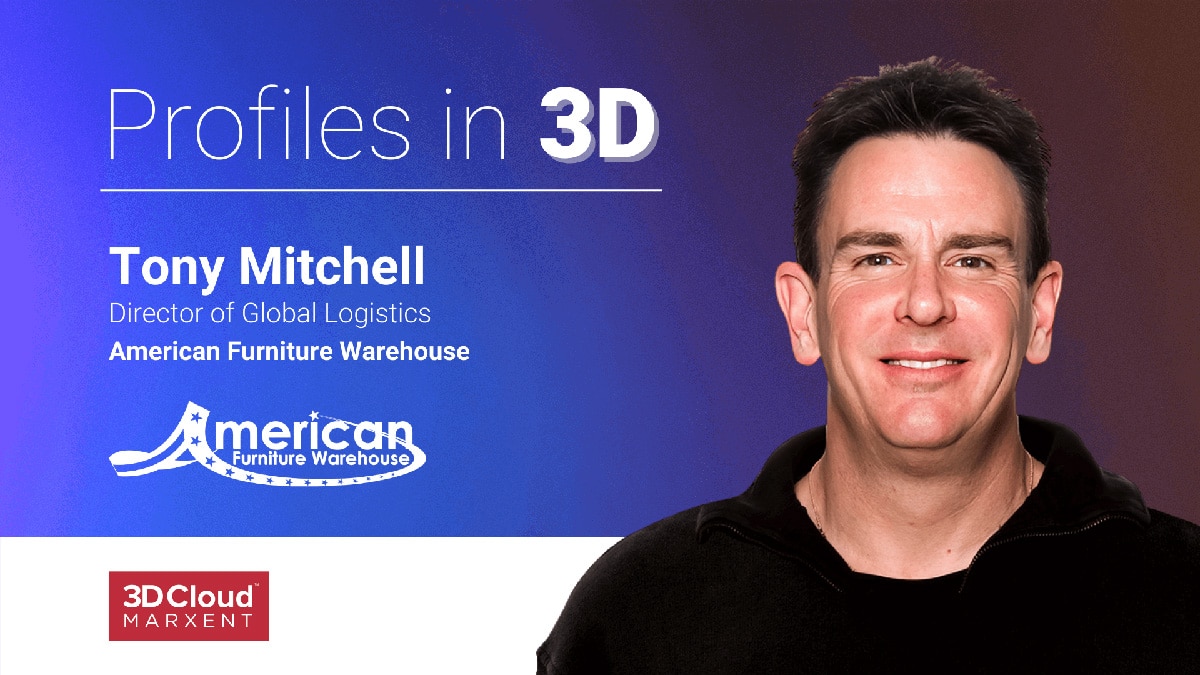
About Tony Mitchell, Head of Global Logistics and Digital Innovator for American Furniture Warehouse
Tony Mitchell is the Director of Global Logistics and Head of Digital for American Furniture Warehouse. He has been in the furniture business for nearly three decades and has loved every minute of it. Tony launched the first website for AFW in 1997 and continues to lead their digital efforts. His passions (besides furniture and technology, of course) are his family (which includes many dogs), the outdoors, fly fishing, travel, and ancient history. He has traveled to Egypt, Israel, Cambodia, China, Russia, and more but Mexico holds a special place in his heart. The people, the taco stands, the furniture – enough said.
Included in this interview:
- Can you tell me a little bit about your background?
- What is the scope of your responsibilities today?
- You mentioned home office. What does that category look like?
- Furniture retail is a competitive business. How are you winning?
- How many stores does AFW operate?
- You have sustainability. You’re thoughtful in your approach.
- Tell me what you do in 3D today and when you got started.
- Our experience was that early adopters of 3D and AR had nimble decision-making processes. Was that true for AFW?
- Some companies say they don’t want to be first, they want the kinks worked out.
- Do you offer a design service?
- Do you plan to put your 3D Room Planner in the hands of sales associates?
- What is next for 3D that hasn’t been explored yet?
- Have you been thinking about replacing your product photos and PNG 360 spins with 3D mid-poly models?
- What’s your position on AR apps vs. Web AR?
- If you were advising someone who was brand new to the furniture industry and was investigating 3D, what would you tell them about how to approach and staff 3D efforts?
Can you tell me a little bit about your background?I’ve been with American Furniture Warehouse for 27 years. Once this business gets in your blood, people don’t leave. I love it. I started here in 1994, buying electronics and other goods. In 1996, I started buying furniture. Soon after I started traveling to Asia on buying trips. By 1997 I was managing our web presence. I had been doing database programming at an electronics store that closed and I just fell into it. By 1999, I was managing both our online product assortment and the overall customer experience.
I knew our products and understood how to standardize the data. We had poor content at the time – that would be an understatement. So that’s where I started with online projects. I was also involved with building a subscription-based online import sourcing catalog for a buying group, which was a fun side project.
What is the scope of your responsibilities today?
It runs the gamut. I’m a student of the business and of retail in general. I’m still involved in global logistics, vendor management, and still buying rustic and vintage furniture from Mexico and India. I’ve done it for about 21 years. I also bought home office and entertainment for 20 years. I do all of this in addition to managing our web presence. I’m not a true developer but I’m also not ignorant to how it comes together.
You mentioned home office. What does that category look like?
It’s been a great category for us. We are bigger than most furniture stores and Jake Jabs (the founder of AFW) likes to commit to categories. Because of this, we have always had a great home office collection. We’ve continued to grow our home office selection this year by onboarding partners with direct ship and adding new lines.
Furniture retail is a competitive business. How are you winning?
Our core values are value and honesty. We’re more of a service-based operation than a sales-based operation. Additionally, we don’t put a lot of focus on things that aren’t the core product. We let shoppers take their time, shop around, sit down, leave – be comfortable. There’s no pressure. The stores are big, inviting, and well-merchandised. Amazon hasn’t yet killed the furniture store. People want to touch and feel it and we are here for them.
How many stores does AFW operate?
We have 14 stores right now.
You have sustainability. You’re thoughtful in your approach.
We’re building more warehouses to serve the need for immediate gratification when it comes to fulfillment. We don’t set that expectation — Amazon does. There is a lot of pressure to deliver quickly. Today is good, yesterday would be better — but you can’t tell buyers that it will take 4 to 6 weeks to deliver a sofa. They just won’t accept it.
Tell me what you do in 3D today and when you got started.
Today AFW offers both a 3D Room Planner and an Augmented Reality app. It has been about 3.5 years since we started with 3D. Right before Apple’s ARKit came out. I had come across 3D in a few different places. Of course, I’ve known Scott Perry forever and he built an AR app that was as close to touching an online product as you could get at the time. That app was well ahead of its time. Furniture needs to be explored, touched, felt, interacted with and that was as close as I’d seen.
Then I encountered some people knocking around at [High Point] Market doing 3D demos. I met with a Marxent salesperson and after really looking at it and studying Marxent it made sense to us to go with you guys and to be ahead of the curve. Our ownership is very supportive and was open to innovation. Credit goes to Jake [Jabs] on that one.
Our experience was that early adopters of 3D and AR had nimble decision-making processes. Was that true for AFW?
We don’t have shareholders in New York who need to bless every decision. More importantly, we didn’t need a hard ROI to do something innovative. Waiting to see the ROI before you act means that you’ll always be behind and never caught up.
Some companies say they don’t want to be first, they want the kinks worked out.
They are in luck! At this point, they don’t have to worry about being first. It’s already been done. But waiting for all the kinks to get worked out? You’re going to be waiting for a long time. The industry is already moving forward with 3D.
Do you offer a design service?
Not formally, but we do offer some design help as part of the sales process. The better salespeople can do house calls to help customers with design challenges.
Do you plan to put your 3D Room Planner in the hands of sales associates?
Absolutely. There is room for a tool to help salespeople who are not professional interior designers better help customers. I’ve always believed in giving salespeople simple effective tools. I don’t like to offer tools that are overly complicated because you lose everyone and it’s a waste of time. The 3D Room Planner is simple enough to use that any salesperson should be able to use it to help customers.
What is next for 3D that hasn’t been explored yet?
I like Virtual Reality but it isn’t practical for our stores right now. Once VR gets to be more of a home experience, I think it will be great for furniture retail. Acceptance is already growing. Of course, there is room for improvement when it comes to realism. Also, multiple items in AR would be nice. We get that request all the time.
Have you been thinking about replacing your product photos and PNG 360 spins with 3D mid-poly models?
With AR the customer’s expectation of quality is 5 of 10, on a product page they expect photographic quality – 10 of 10, We haven’t been able to get to the quality with models yet to make them better for product pages, but it looks like Marxent is getting close.
What’s your position on AR apps vs. Web AR?
There is still some pushback and hesitancy to downloading apps. We have to entice people with social and regular media. Until you use it, it’s hard to understand the experience – getting away from the local app ecosystem. Using app clips or teaser downloads may help to encourage downloads in the future.
If you were advising someone who was brand new to the furniture industry and was investigating 3D, what would you tell them about how to approach and staff 3D efforts?
We haven’t hired an army of developers. Marxent has done the heavy lifting. I don’t think we’ve scratched the surface on what we can do with the content. If you have money to burn. If you’re a giant company, maybe do it yourself. If you’re an independent company, Scalability, speed to market is important and it seems like a slow path to go it alone and hire your own crew.
3D is both art and science. I haven’t had the desire to onboard people directly. I could hire 20 people and they wouldn’t be as good as you guys. If we traded places, I don’t know how good you would be as a furniture merchandiser but I know that you’re better at 3D than anyone I know.
It’s good to have great partners to create a great product












